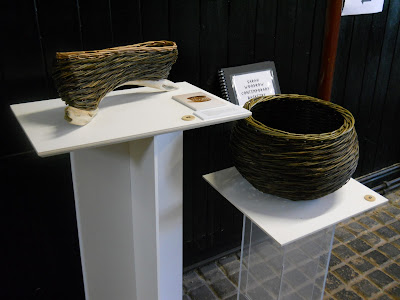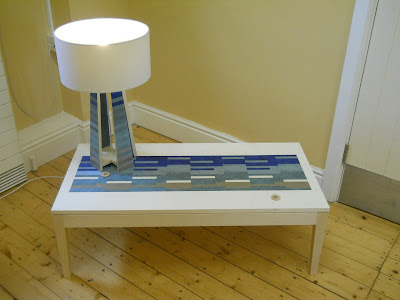First of all, sketching out a few ideas on paper helped to give a clearer vision. It allowed me to work out how the different features such an animal would have evolved for it's lifestyle could come together and also what kind of pose to show it in.
Then, I made a very simple clay model to further settle things in my mind. The model is very different from the final sculpture. but it has a charm of it's own. I think it looks a bit like an aardvark!
With the pose of the animal starting to become more apparent, it was easier to choose a block of wood for the body. I settled on a piece of locally-grown cherry wood. It was the right size and colour and not too strongly grained (which might have interfered with seeing detail). It is also great to carve - it would certainly be in my top three favourite timbers to work on.
Sketching out the form of the sculpture very roughly and directly onto the block showed where to cut away material to get the basic form. I cut some waste away with a bandsaw, but the piece of wood was a little too large and difficult to secure whilst cutting. Instead, roughly shaping with a Holey Galahad seemed a better option.
This tool is a metal disc shaped like half a ring doughnut and covered with small, tough metal spikes. It fits onto a standard angle grinder and spins round, removing timber, with the holes in it allowing the user to see where they are cutting more easily. You need to be careful when using it, but it's a handy tool to have.
You might notice the steel-toed boots, dust mask, safety specs, ear defenders and chainsaw gloves in the photo above. Not taking any chances!
The Galahad roughed out the shape from the block nicely, but then it was time to turn to more traditional carving methods. With the piece still fixed onto a woodcarver's adjustable stand, it came back into the workshop...
The shape of the head, body and the limbs was then carved by hand during the next sessions using traditional gouges and chisels, some over a hundred years old. This process took over 35 hours.
The hands and feet were whittled from apple wood, picked up in the garden of my rented accommodation years ago. I used a four inch long Opinel lock knife, the same one that I taught myself to carve with about nineteen years ago. It is still my favourite carving tool and can achieve some surprisingly delicate work with a bit of practice.
The colour of the apple wood contrasts nicely with the cherry. It's very different to most apple timber that I've come across before.
Before being fitted, the hands and feet also had their claws glued on with two-part epoxy adhesive. The claws were carved from locally-grown holly using the Opinel and then sanded.
Whilst working on the hands and feet, the muzzle and eyes were also taking shape. The muzzle was whittled with the Opinel from an offcut piece of English Walnut, with the nostrils and whisker holes shaped using a Dremel hand drill. The mandible was carved from the same cherry timber as the head and body, the teeth are locally-grown boxwood and the tongue a piece of Yellow Box Gum, a didgeridoo offcut picked up whilst travelling in Australia.
The eyes were carved from an offcut of Pau Amarello that was being thrown away at a woodyard. I wouldn't choose to buy this timber newly cut as it grows in Brazil, even though it isn't classed as threatened there. However, it seems wrong to chuck away any offcuts of an exotic timber and I also keep even the smallest potentially usable pieces that are offcuts of my own carving. The same is true for the ebony inlaid as the pupils in the eyes. I believe that Madagascan ebony is endangered and shouldn't be bought in any circumstances, but I have lots of small bits of African ebony that were broken sculptures or were going to be thrown away by other people and I save them down to the smallest usable piece. When it is gone, that's it. I might experiment with charred holly or something similar instead.
The eyes were finished with gloss varnish to give them a shine. The varnish can be better dripped on than painted on, to avoid brushmarks. They were set in using two part epoxy mixed with wood dust, to give a tiny differently coloured ring around them, like an eyelid membrane. They are quite staring, which suits a creature that is supposed to be a nocturnal hunter.
The next job was to carve the fur texture. The Dremel hand drill was good for this, using two differently sized rotary burrs (ridged spherical bits). The rounded burrs gave a smoother, less coarse appearance to the carved fur.
After all the components for the mammal were complete it was time to glue it together using slow-drying two part epoxy ( I used Araldite):
...and while it was setting, there was time to carve the pupa that it is about to eat. This was whittled using the Opinel from an offcut of English brown oak and was inlaid with boxwood, plum, cherry and holly, all grown in the local area.
The pupa was finished with Danish oil, as this gave a slight sheen to the surface.
The base on which it all stands was reshaped from a piece of Honduras mahogany that had been salvaged from the renovation of a school in Exeter in Devon. It was varnished and then had a bit of sawdust sprinkled on it, to look like a taxidermist's vignette. It proved surprisingly difficult to find the correct shape of branch to complete the piece and it took about an hour of searching around the woodyard and a shortlist of about ten candidates to find the right one!
Finally, it was time to assemble the sculpture. I glued it together using slow-drying two part epoxy. The quicker-drying stuff really isn't worth bothering with, it has no strength in it. All the pieces were supported using a selection of blocks and sticks while they dried. The whiskers, made from fibres of bamboo from an old skewer, were glued in at this point.
Finding the right finish for the areas meant to represent skin and fur presented a bit of a problem. Waxes and oils would give a slight shine to the surface, which wasn't appropriate for the 'furry' finish. I chose instead to use wood preserver, which doesn't have any kind of shine at all when it dries. It was only applied to areas that hadn't already been finished with, for example, varnish.
So, after over one hundred hours of work, the metainsectivore was finished and ready to show.
If you have come here from my website, clicking here will take you back there.
























































